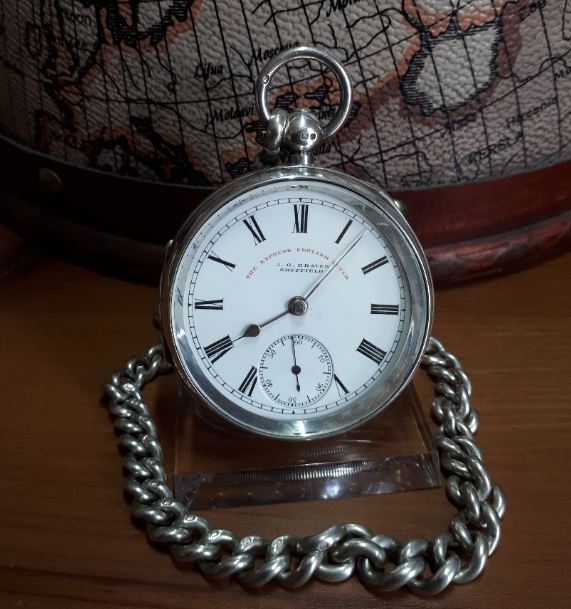Watches were made in Prescot from the early 1700s. During the 18th and 19th centuries, it was at the centre of the Lancashire watch and clockmaking industry. The expensive, high-quality watches and clocks were produced by hand in workshops attached to the workers’ houses. Prescot was often described as a ‘town of little workshops’. The craftsmen specialised in making different components of the watches, using precision hand tools. This was, in essence, very similar to the traditional Swiss établissage system. The township gained widespread recognition as a centre for high-quality horological craftsmanship. The Lancashire Watch Company was one of the largest watch manufacturers in Prescot.
Workshops
The watchmaking workshops were attached to the houses and could generally be recognised by the large north-facing windows to allow as much daylight in as possible. Work benches were raised to windowsill height. The precision tools, such as files and screwdrivers, were stored on a shallow shelf above the windowsill. The workshops would be heated by an open coal fire or a cast iron pot stove. When the natural light faded, the workshop would be lit by gas lamps.
The small town thrived on the industry and in 1860 over a third of the town’s population were employed in the trade. This made watchmaking a critical economic component for the entire region. At the time, watchmaking was considered a respectable occupation despite the long hours and the limited holidays. However, during the 1870s fierce competition from cheaper, machine-made watches produced in America and Switzerland hit the local industry badly. The proud local workers were reluctant to let go of their traditional skills, but they simply could not compete with the more modern manufacturing process. By 1885, after a rapid decline, most of the workshops scattered through the town had closed down.
Establishment
A certain Thomas Peter Hewitt decided to revive the industry by establishing the Lancashire Watch Company in 1889. Hewitt hoped to rival the large American and Swiss watch companies and adopted a more modern approach to watchmaking. Firstly, he combined all of the different manufacturing processes under one roof, producing complete watches from a single factory. The new company bought up many of the old Prescot workshops, complete with their workers and equipment. The main factory was on Albany Road, with a warehouse in the ‘Flat Iron’ building, Eccleston Street. The typical employee was male, but women were also employed in the watchmaking trade. However, when the Lancashire Watch Company was founded it had a strict policy that only unmarried women could work there. Once a female employee got married, she had to leave her job at the factory.
The high level of manual skill required to use the traditional tools used in small workshops was no longer required. The modern manufacturing process used machinery that produced large quantities of identical watch components with little need for adjustment. Semi-skilled or even unskilled workers could easily operate them. Steam power reduced physical fatigue and large numbers of components were quickly produced.
The watches produced in the factory had more in common with earlier American designs than traditional English fusee watches. They produced two main types of watches. Rough or blank movements, which were sold, primarily to London, and finished elsewhere. Finishing involved adding the gear train, jewels and the escapement. They also made complete, finished watches, including cases, by machine. The vast majority of Lancashire Watch Company watches were sold to other finishers, J.G. Graves was a prominent example, and only a small proportion was sold as Lancashire Watch Co, Prescot.
Competition
Because of economies of scale, the Lancashire Watch Company struggled to compete with the larger American and Swiss factories. One of the reasons it may have struggled is due to the number of movement types and models it made, which probably created many manufacturing complications and a reduction of potential profits. For example, the 1898 price list describes eleven models, each with six case sizes. This would require 66 separate sets of tooling. Re-setting equipment to cater for each model would have taken time and reduced production volumes. Additionally, the company struggled with debt and some dubious accounting activities.
The Lancashire Watch Company made itself the prisoner of potential demand for a huge number of specific consumer requirements. This made it difficult for them to focus on the development of new manufacturing technologies and production and marketing strategies. What the firm needed was a narrow range of standardised and mass-produced products for sale. The reality was, that they were unable to compete against the Swiss and American watch manufacturers that had abandoned old production technologies and had modernised their business practices.
The end
In a last-ditch attempt to survive the Lancashire Watch Company attempted to compete on price and design. They launched the ‘John Bull’ pocket watch in 1909, which was a basic model with a pin-lever movement. The movement contained no jewels, so it was highly susceptible to wear and tear. It was probably the first ‘disposable’ English watch and sold for only 5 shillings, equivalent to an average day’s wages at the time. However, only five thousand John Bull watches were ever sold, which was not enough to save the company.
In total, the Lancashire Watch Company failed four times. First in 1898, because incorrect accounting was used to favour ordinary shareholders, which created unexpected losses. The company survived after restructuring. Second, in 1906, when the company’s unpaid debt forced the debenture holders to take over. Third, in 1908, when “B” debenture holders forced the company into receivership and enough debt was serviced to remain afloat. Lastly, in 1910, when all hope was lost and the company was finally liquidated. The company closed in January 1911, and the factory contents were sold by a public auction that ran for 9 days. During its 21 years of existence, an estimated 80,000 watches were produced annually.
